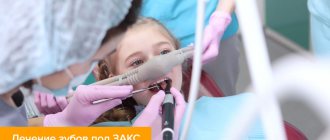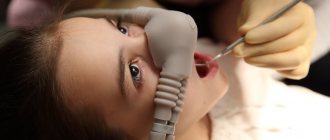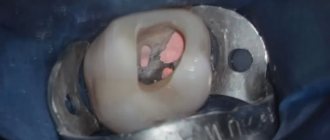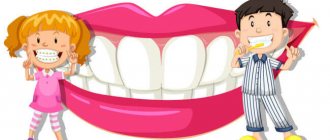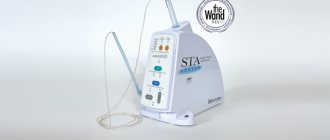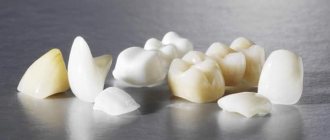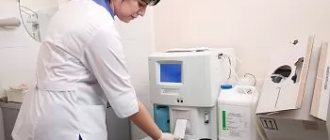Every parent knows how difficult it is to bring a child to the dentist and even more difficult to persuade him to sit quietly in a chair for 20-40 minutes.
As a rule, such problems arise in children who have already experienced stress when visiting a doctor. The dentists of the SM-Doctor clinic know a way out of the situation. For several years now we have been providing dental treatment for children under sedation. For this purpose, SM-Doctor uses nitrous oxide (a mixture of nitrogen and oxygen) - a medical gas that has a general calming effect. As a result of exposure to a specially selected gas mixture, the child remains conscious, but at the same time he relaxes, stops being restless and fidgeting. The child’s contact with others is not disrupted; he can communicate with his parents and respond to the doctor’s requests. All this allows the pediatric dentist to calmly and efficiently perform the necessary medical procedures.
How does nitrous oxide sedation work?
This procedure should not be confused with general anesthesia. During treatment under sedation, the child does not sleep, but is in a relaxed state. He continuously breathes through his nose with a special breathing mixture in which ordinary nitrogen is replaced by nitrous oxide (N2O).
It is a harmless gas with a pleasant odor, which when inhaled improves mood, relaxes and dulls the feeling of fear. Thanks to this, the child sits calmly in the chair, is not afraid of dental instruments and allows the doctor to treat his teeth.
Nitrous oxide sedation in pediatric dentistry
preferable in the following situations:
- the child experiences panic and refuses treatment;
- with any manipulation of the dentist in the oral cavity, he experiences bouts of nausea;
- a complex and lengthy procedure is expected, and general anesthesia is not suitable for some reason;
- the child is afraid of treatment due to negative experiences in the past;
- This is the first dental treatment, and parents do not want their child to develop a fear of dentists.
To better understand how children
During
dental treatment with nitrous oxide
, remember how you feel after a glass of wine. A good mood, a dulling of fear, a feeling of comfort and serenity - all these feelings help the child to relax and calmly watch a cartoon while the dentist is working on his teeth.
Sedation scheme
The patient puts on a mask, and 100% oxygen first enters his lungs. The oxygen mass is supplied at a speed of 4-6 liters per minute. Nitrogen is gradually mixed with oxygen. Its content is increased to 30%. When the proportions of nitrogen and oxygen are brought to a ratio of 30 to 70, respectively, the moment comes favorable for starting treatment. However, it should be noted that the concentration of nitrous oxide may vary depending on the individual patient. It is important to achieve the desired effect, and it, in turn, can occur with a different ratio of nitrogen and oxygen. Individual indicators are recorded in the patient's record.
The blood is saturated with gas in about 5-7 minutes. Nitrous oxide is completely dissolved in blood serum and is not biotransformed in any way. As soon as the supply of ZAX stops, the process of removing gas from the lungs begins. The gas is removed completely unchanged.
ZAX differs from other sedatives in that the sedative effect occurs very quickly, and the trace effect is completely absent. This is caused by nonspecific depression of the central nervous system.
Sedation manifests itself as follows: a comfortable and relaxed state; good, elevated mood; movements are inhibited; deep breathing; motor activity of the eyes is reduced; sound perception is dull; resistance is reduced.
If you plan to undergo a particularly painful procedure, you can temporarily increase the concentration of nitrous oxide to 50% (acceptable limit is 70%). Nitrous oxide has an analgesic effect, and also enhances the effect of local anesthetics. If the child is suddenly frightened and painful sensations begin to “reach” him, manipulation with nitrous oxide will quickly calm the baby down and treatment can be continued.
Thus, the use of ZAX makes it possible to carry out treatment of any complexity in just one visit.
As for removing the patient from the state of sedation, it occurs smoothly and consists of supplying 100% oxygen for 5-10 minutes. At this time, the doctor communicates with the child, trying to reinforce his positive impressions of visiting the dental office.
In general, the successful use of ZAX is impossible without the competent use of behavior management techniques. Trying on a mask by a child should be done in a playful way so that the child has time to relax before the onset of sedation. The doctor calms the child by telling him about the condition he will soon find himself in. You cannot force a mask on, as this may cast doubt on the success of the procedure.
The use of nitrous oxide in pediatric dentistry
The relaxing and calming effect of nitrous oxide lasts only a few minutes, so the child must breathe the sedative mixture continuously throughout the treatment. For this, a special nasal (worn over the nose) mask is used, which does not interfere with the dentist’s work.
At the Natadent clinic, dental treatment for children under nitrous oxide usually includes the following steps:
- The doctor talks with the little patient, explaining to him what will happen next.
- The child lies down in a comfortable chair, above which there is a large screen with a cartoon.
- The doctor puts a nasal mask on him.
- When relaxation occurs, the doctor begins to work. If necessary, local anesthetics are used in the form of sprays and injections.
- During the entire procedure, the child remains conscious, so the doctor and parents can communicate with him.
- When the treatment is finished, the mask is removed and after a few minutes the child returns to his normal mood.
As you can see, nitrous oxide sedation
has nothing to do with anesthesia. Her main task is to create the most comfortable conditions for the child so that he tolerates the treatment well and is not afraid of the dental office in the future.
Features of the preparatory stage
Treatment of primary teeth under sedation does not require prior special preparation (due to the minor impact on the body). However, it is worth undergoing laboratory and instrumental examination to identify possible contraindications and avoid the development of an allergic reaction. If absolute contraindications are found, the doctor will suggest another way to solve the problem.
Psychological preparation is recommended. Parents should talk to their child in advance and explain the importance of going to the dentist. The main thing is not to alarm him, but to calm him down before the visit to the clinic, to prepare him to accept a specialist. An excellent way to prepare your child for a trip to the dentist is to play “dentist”: treat teeth with your favorite toy, and during the game tell him what manipulations the specialist performs and how to behave correctly in the dental office. At the same time, the story should be interesting and not cause a feeling of fear.
All children are different. Some people calmly tolerate any trips to clinics, but for others it is better if they do not know in advance where and why they are going. In any case, experienced doctors will be able to establish contact with the child, calm him down and tell him in a playful way about the upcoming treatment.
Benefits of dental treatment in children with nitrous oxide
In modern dentistry, effective and relatively harmless drugs for general anesthesia are widely used. But it is better to avoid them if possible. Sedation with nitrous oxide allows a child to undergo dental treatment without pain and discomfort, without resorting to anesthesia. Therefore, the doctors at the Natadent
recommend sedation whenever appropriate.
Benefits of Nitrous Oxide Treatment in Pediatric Dentistry
:
- rapid onset of effect and rapid return to normal well-being;
- high efficiency, especially when treating children;
- no health consequences;
- minimum contraindications;
- absence of allergies and side effects (including nausea, which is characteristic of all anesthesia drugs);
- the opportunity to communicate with the child during treatment.
Under sedation, the child is in an extremely relaxed state, watches a cartoon and does not want to go anywhere. Thanks to nitrous oxide, pediatric dentist
can work on his teeth for up to one and a half to two hours, whereas usually children can hardly stand even 20 minutes in the dental chair.
At the same time, the child himself develops a positive experience. He remembers that several teeth can be treated at one time without experiencing discomfort. Thanks to this, next time he will come for treatment much more willingly. And instead of fear, as often happens, he will develop an understanding of how important it is to visit the dental office in a timely manner.
Anesthesia and sedation: what are the differences?
First of all, anesthesia implies a complete shutdown of consciousness and reflexes. During anesthesia, the patient cannot speak, interact with the doctor, or generally be aware of what is happening. Sedation, on the contrary, leaves the patient conscious (partially) and preserves all reflexes. Of course, anesthesia involves the use of another group of drugs that help achieve a certain state. In a sense, the effect of sedation is also achieved during anesthesia: this is one of its stages when, before falling into deep sleep, the patient experiences calm and tranquility. Anesthesia is considered a radical measure, especially for a fragile child’s body. It is not recommended to put a patient (and especially a child) into a state of anesthesia unless absolutely necessary, since potent drugs are used here, which also affect the functioning of the cardiovascular system.
Our prices
When using nitrous oxide in dentistry
For children, the price of the procedure increases slightly. This is explained by the fact that expensive equipment is used, plus another doctor is involved in the operation to monitor the patient’s condition. But sedation can save the child from suffering, so it’s better not to skimp on it.
Prices
Use of nitrous oxide sedation
85 rub./minute
At the children's dental clinic " Natadent"
» you can receive high-quality treatment using modern methods of sedation and anesthesia without overpayments. Despite the use of expensive advanced equipment, we strive to keep prices at an affordable level.
Contraindications
Today, nitrous oxide is used almost everywhere, and reviews of the procedure are mostly positive. This was largely because the use of this gas does not require a special license, which is required for other types of sedation using psychotropic substances. Because of this, ZAKS is sometimes taken quite lightly. Meanwhile, this procedure has an impressive number of contraindications and restrictions that must be kept in mind to avoid complications and side effects:
- the age of the patients is too young—ZAKS is not recommended for children under three years of age;
- upper respiratory tract diseases (colds, runny nose, rhinitis, sinusitis);
- adenoids;
- otitis in the acute stage;
- traumatic brain injuries (3 months or earlier before the start of treatment);
- seizures and epilepsy;
- lack of possibility of contact with a doctor - when performing ZAKS, the doctor must understand the child’s condition and reaction;
- individual manifestations of the reaction (convulsions, allergies, reverse reactions).
Side effects of ZAX are usually associated with the individual reaction of the child’s body to the components of the mixture. It happens that instead of a relaxed and calm state, we get the opposite reaction: hyperactivity, sudden movements, panic states. In this case, the gas supply should be stopped immediately, as there is a high risk of harming the child and only increasing his fear of dental treatment. If allergic reactions occur (shortness of breath, cough, redness), the doctor should also interrupt the procedure and give the patient antihistamines.
Reviews
Natadent Clinic
– one of the few
pediatric dentistry in Northwestern Administrative Okrug
that actively uses
nitrous
in dental treatment for children.
This practice is widespread in Europe, the USA and Israel, but in Russia there are still few such clinics (even in Moscow,
not everyone uses sedation).
By contacting us, you can be sure that your child’s teeth will be treated with high quality, and he will experience a minimum of discomfort and will henceforth want to be treated only with us. You can read the reviews to make sure that our little patients and their parents always leave us happy.
LEAVE FEEDBACKFAQ
Is it possible to eat before anesthesia?
No you can not. And parents need to not only tell their child about this, but make sure that he doesn’t eat too many cookies from his secret reserves. The child is hungry, he will try to eat at least something. Anesthesia on a full stomach may result in vomiting during treatment or upon awakening. If it is “in the process of treatment,” then the substance can block the airways, which is not necessary for anyone.
How easy is the anesthesia to tolerate?
If all protocols are followed and the process is monitored by an experienced anesthesiologist, then everything goes without problems or any special side effects.
To do this, we comply with all protocols and everything that is necessary for complete safety. For example, here is a study that suggests that with proper anesthesia with propofol and isoflurane, all side effects after waking up last less than a day. But sometimes our hair just stands on end when a mother comes to our clinic after a not very proper anesthesia in another place. We usually catch these parents with a week's worth of food and the moral expectation of three days of continuous vomiting and dizziness after waking up. Here you immediately understand that in another place the general anesthesia did not go quite right.
Will he really wake up?
Yes. It's not a matter of probability, it's a matter of following protocol. You need to check the equipment, have a doctor with the required qualifications, and understand the characteristics of a particular patient. Then there will be no surprises. The process is closely monitored by an anesthesiologist-resuscitator, who is ready to intervene at any time and adjust the anesthesia parameters. He knows how to smoothly introduce and recover from anesthesia, and knows all the nuances of resuscitation measures in children.
I was told about doctors who are against anesthesia
Yes, this happens.
But I think that they are not entirely right and they simply do not have a good anesthesiologist. The safety of general anesthesia for the health and mental abilities of the baby is confirmed by numerous studies. For example, they took 19,296 children and studied their development after many anesthesia experiences up to the age of 20. The results prove that everything is fine, and the children are no different from their peers. At the same time, many sources still come to the conclusion that repeated anesthesia before the age of two is undesirable. In general, sometimes misunderstanding and fear of general anesthesia take strange forms among some doctors. I remember one wild case when a doctor tried to protect children from terrible anesthesia by replacing it with temporary suffocation with a towel. Binds, holds and treats half-strangled. Such a kind doctor. Moreover, in fact, she uses a version of raush anesthesia. It’s just that it was relevant several hundred years ago, when even ether anesthesia was not invented, and the only option to carry out a conditional amputation was a precisely calculated blow to the crown of the head with a wooden mallet. But it was difficult to control the “depth” of such anesthesia and guarantee successful awakening.
What happens to the eyes during treatment?
The eyes dry only during deep anesthesia; in our case, they are sufficiently moistened with tears. The patient's eyelids are fixed with a special plaster. This way the eyes remain closed and the mucous membrane does not dry out. Well, there is no risk that something could get into them.
Will hair fall out after surgery?
I know it sounds strange, but parents ask this. The point is this: if you lose a lot of blood during surgery, hair loss may be a side effect. But when a mistake is made in surgery, it is most often attributed to uncontrollable factors in the spirit of: “This is a drug for anesthesia,” and not to the fact that someone was unable to perform the manipulation on time or did not make the right decision. And the anesthesiologist has nothing to do with it.
Will this affect the child’s memory or damage the brain?
It won't have any effect - neither good nor bad. The anesthesiologist carefully monitors the saturation level so that the young brain receives enough oxygen. The device does not supply pure gas, but mixed with oxygen. All sensors are built into the ventilator. If necessary, the doctor can, for example, adjust the composition of the gas mixture. All drugs have an excellent safety profile and a bunch of studies confirming their safety when used in pediatric patients. We also know how to work quickly. If on very voluminous interventions we used to work for six hours, then up to four, up to three, now the average duration is no more than 2.5 hours: this, in particular, is why technology and a professional team are needed.
Will he have bad dreams?
Will not. The child will not remember the process of anesthesia itself and, most likely, some short period before it. Just try not to frighten him again: children are very impressionable. Then we will try to make everything as comfortable as possible for him: he fell asleep, woke up, and then played.
Why is it so important not to scare a child?
The most difficult thing in dentistry is not to scare a child.
Unfortunately, this is often done for us by some strange grandparents who scare the child with doctors. Please never tell your children things like: “If you eat candy, you will ruin your teeth. And then the doctor will use a terrible drill to drill your teeth.” Sooner or later, a small patient will have to encounter a dentist. And we would like him to trust us, and not run away screaming at the sight of a white coat. Otherwise, everything can end with persistent dental phobia, a mouth full of dentures and a bunch of problems for life. PS
In previous posts about palatal expanders and the scientific approach to dentistry, you asked about the clinic. If you want to treat your teeth with us, then say “I’m from Habr”, there will be a small 5% discount.

